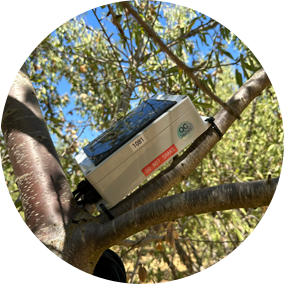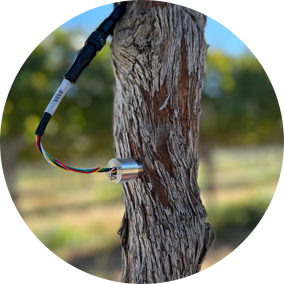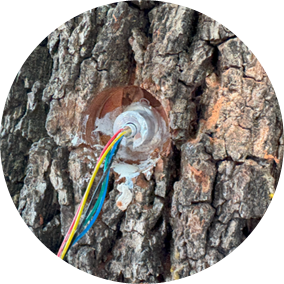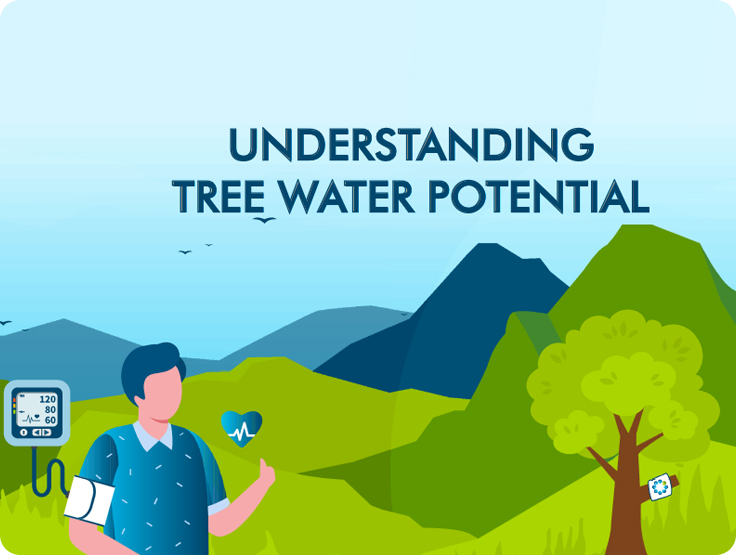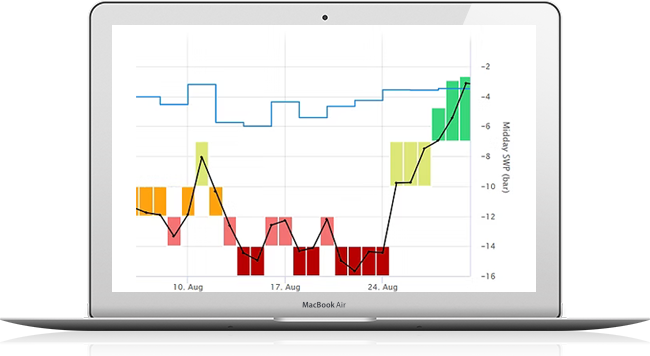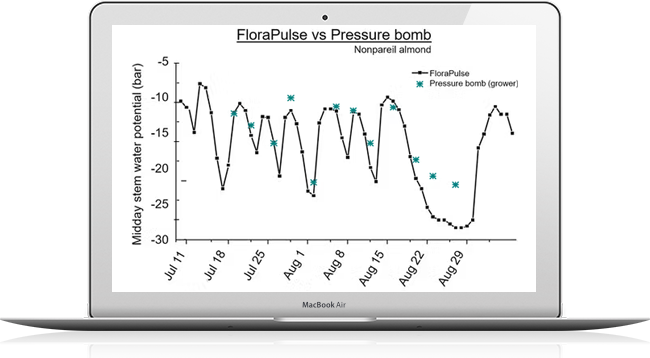About
FloraPulse
Retire the pressure chamber, know exactly when to irrigate, increase crop yield and quality.
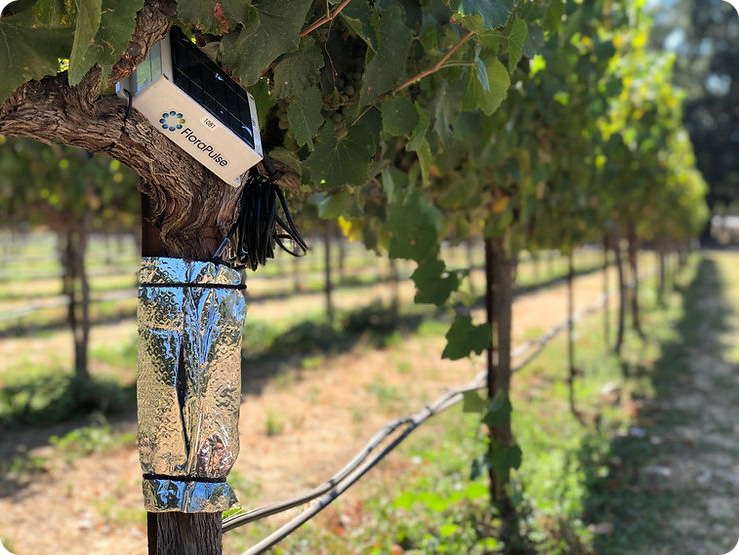
FloraPulse began in the orchards and vineyards of growers.
Since the 1970’s, Alan Lakso, professor of Horticulture at Cornell, had been dragging around the heavy, manual pressure chamber to measure and manage water stress in apple trees and grapevines. Alan was documenting the levels of water stress and their effect on fruit growth and quality. Back then, winegrape growers understood that water stress was important to wine quality, but only had the pressure chamber to measure it.
Why FloraPulse?
Vineyard Irrigation: The Core Essentials
I have over two decades of experience working with vineyard irrigation systems, and Vineyard Irrigation California stands out for its unique challenges and opportunities. With California’s unique climate, irrigation is not just a tool; it’s a lifeline. To ensure thriving vineyards, understanding soil type, vine variety, and regional climate patterns is crucial. Efficient irrigation is key to countering California’s frequent drought conditions while maximizing yield and quality.
Effective irrigation in vineyards requires a balance between technology and traditional methods. Using advanced sensors, like those offered by FloraPulse, combined with visual assessments ensures a holistic approach to water management. By evaluating irrigation system performance regularly and adjusting according to precise data, growers can optimize water use while maintaining the health of the vines.
Choosing Effective Irrigation Methods
Choosing the right irrigation method for Vineyard Irrigation California involves several considerations. Drip irrigation remains a popular choice due to its precise water application capabilities, essential in regions where water conservation is paramount. However, there are alternative options to consider:
- Surface Irrigation: Suitable for flat terrains, it leverages gravity but requires careful management to avoid water wastage.
- Micro-irrigation: Ideal for hilly vineyards, this method delivers water directly to the root zone, reducing evaporation losses.
- Overhead Sprinklers: Although less water-efficient, they can be effective in cooling the vineyard during heat waves.
The effectiveness of each method depends on factors such as soil type, topography, and vine root structure. Combining technology like FloraPulse’s precision sensors can enhance any chosen method by providing critical data on vine water stress and needs.
What Common Problems Affect Vineyard Irrigation in California?
Vineyard Irrigation California faces numerous challenges, particularly related to drought conditions and water scarcity. A common issue is the inconsistent distribution of water due to clogged emitters or uneven terrain. To address this:
- Perform regular maintenance on irrigation systems, including flushing out emitters.
- Use sensors to monitor water distribution and adjust emitters as needed to ensure uniformity.
- Implement regulated deficit irrigation (RDI) to maintain vine health and optimize water use.
By addressing these issues, vineyard managers can improve water efficiency and vine productivity. Additionally, understanding the specific water needs of different vine varieties can play a significant role in overcoming these challenges.
How Are New Technologies Enhancing Vineyard Irrigation in California?
Advancements in technology have revolutionized Vineyard Irrigation California practices. The integration of data-driven insights into irrigation strategies has been transformative. One such innovation is the use of FloraPulse sensors, which provide accurate stem water potential measurements directly from the vines. This precise data enables growers to make informed irrigation decisions, thereby optimizing water usage and improving vine health.
Additionally, deploying drones for aerial vineyard assessments can provide valuable data on soil moisture levels and vine stress. Together with smart irrigation systems, these technologies empower growers to respond proactively to changing conditions, ensuring sustainability and productivity.
Leveraging these technologies not only aids in managing water resources more effectively but also supports the environmental sustainability goals of the vineyard industry in California.
Sustainable Practices in Vineyard Irrigation California
Sustainability is at the forefront of Vineyard Irrigation California, with a strong emphasis on conserving water resources while maximizing agricultural output. Here are some sustainable practices to consider:
- Rainwater Harvesting: Collect and store rainwater for future irrigation needs, reducing reliance on groundwater.
- Cover Cropping: Planting cover crops can improve soil health and water retention, benefiting the vines.
- Recycled Water Use: Utilizing treated wastewater can supplement irrigation needs while conserving freshwater.
These practices contribute to a resilient vineyard environment, with the dual benefits of enhancing productivity and protecting natural resources. Implementing sustainable irrigation methods aligns with California’s environmental policies, fostering long-term growth and stability in the region.
Emerging Trends in Vineyard Irrigation California
With ongoing climate changes and technological advancements, the landscape of Vineyard Irrigation California continues to evolve. One emerging trend is the increased use of real-time data analytics, allowing for the adjustment of irrigation schedules based on live feedback from the vineyard. This approach ensures more precise water application and minimizes wastage.
Moreover, there is a shift towards integrating artificial intelligence and machine learning to predict irrigation needs based on weather forecasts and historical data. This progressive approach has the potential to revolutionize water management practices, ensuring sustainability and improved yields.
As new developments continue to emerge, staying informed and adaptable will be key for vineyard managers looking to maintain competitive and sustainable operations in California’s dynamic agricultural landscape.
What are the unique challenges of vineyard irrigation in California that growers must address?
Ah, California! Known for its stunning vineyards and, unfortunately, its frequent droughts. One of the main challenges is the climate itself, which is often dry and can push water resources to the limit. Growers must understand their specific vineyard environment, including soil type and vine variety, to tailor their irrigation strategy. The use of advanced sensors, like those from FloraPulse, is becoming increasingly essential as they offer precise water stress data that is invaluable in such demanding conditions. A friend of mine who manages a small vineyard in Napa often talks about how these sensors have changed the game, allowing him to tweak irrigation based on real-time data, rather than mere guesswork. Sure, it takes a bit of investment upfront, but the payoff in terms of vine health and grape quality is well worth it.
How can vineyard managers effectively choose the right irrigation method for their specific site?
Choosing the right irrigation method can be a bit like picking a favorite wine–very personal and dependent on specific circumstances. Drip irrigation is a popular choice for many due to its water efficiency, but it’s only one option. Surface irrigation could be ideal for those working with flat terrains, while micro-irrigation suits hilly vineyards. Let’s not forget overhead sprinklers, which, while not the most water-efficient, can help during those intense heat spells. I often recommend combining tech like FloraPulse sensors with any method you choose, as they can provide critical feedback on vine water needs. It’s about finding the right balance that suits your vineyard’s unique needs.
What are some common irrigation problems California vineyards face, and how can they be solved?
Vineyard irrigation issues often stem from the very nature of the environment–like clogged emitters or uneven distribution of water. Regular maintenance is your best friend here. Another useful approach is utilizing sensors to monitor and adjust emitters for uniformity. My colleague in Sonoma swears by regulated deficit irrigation (RDI) as a technique to keep his vines healthy with minimal water use. This method involves applying less water than the vine’s full requirement, encouraging deeper root growth and improving drought resistance. Addressing these issues is crucial for maintaining a productive vineyard, especially when every drop counts.
How are modern technologies changing the way vineyards in California approach irrigation?
The impact of technology on vineyard irrigation is nothing short of revolutionary. With tools like FloraPulse sensors, which provide accurate stem water potential measurements, growers can make precise irrigation decisions. It’s akin to having a detailed conversation with your vines about their needs. Drones also add to this tech arsenal, offering aerial assessments that help in understanding soil moisture and vine stress across large areas. These advancements allow vineyards to optimize water usage, thus supporting environmental sustainability. The success stories from users of these technologies highlight how embracing innovation can lead to healthier vines and higher quality grapes.
What sustainable practices can improve vineyard irrigation management in California?
Sustainability is key when it comes to vineyard irrigation. Practices such as rainwater harvesting and recycled water use can significantly reduce dependency on groundwater. Cover cropping is another method I often advocate for, as it improves soil health and water retention. Imagine your vineyard as a tiny ecosystem–keeping it balanced benefits not just your vines but the entire environment. Embracing these practices aligns well with California’s environmental goals and can lead to long-term benefits for both the land and your wine. What’s more, it often surprises people how these practices can effectively boost vine health and yield.
What are some emerging trends in vineyard irrigation that could shape the future of California’s vineyards?
We’re seeing some fascinating trends emerging in vineyard irrigation, such as the integration of real-time data analytics. With systems that adjust irrigation schedules based on live feedback, growers can react swiftly to their vineyards’ needs. Another exciting development is the use of AI and machine learning to predict irrigation needs using weather forecasts and historical data. These technologies are paving the way for more efficient water use and potentially game-changing improvements in vineyard productivity. If you’re looking to stay at the forefront of vineyard management, these are trends worth watching closely.
How It Works
How It Works
The FloraPulse system is a microchip tensiometer (microtensiometer) that is embedded into the tree woody tissue and directly measures the water status, known as water potential. Because the measurement is taken directly inside the water-carrying tissue, readings are very accurate and reliable. You receive daily midday stem water potential readings, along with science-backed irrigation recommendations.
Weekly Reports
Receive weekly reports on your crop’s water-stress history, color-coded by stress level. Use clear, detailed data to adjust your irrigation and get that perfect vintage, that perfect yield. Every year.
Scientific Validation
The sensor data has been validated against the Scholander chamber with good correlation in prune, almond, winegrape (and others).
Technology Backers

Our technology has been funded by the NSF and USDA, and was originally developed at Cornell University.
What is FloraPulse?
The most accurate way to irrigate.
Customer Testimonials
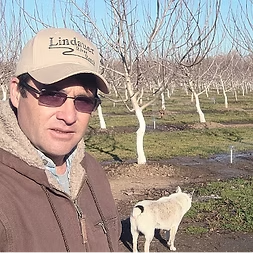

“We were extremely happy with the FloraPulse system we tested in our prune orchard this year. We found that the FloraPulse readings correlated very well with our pressure bomb readings…
Michael Vasey
Lindauer River Ranch
Red Bluff, California
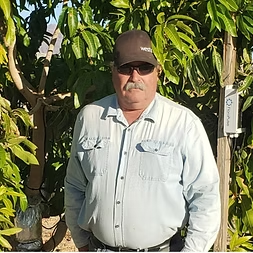

“I am very happy with the FloraPulse unit. I grow a rare mango crop, in a desert environment with extremely high summer temperatures, in alluvium soil that has very limited…
Rod Chamberlain
Wong Farms
Mecca, California


